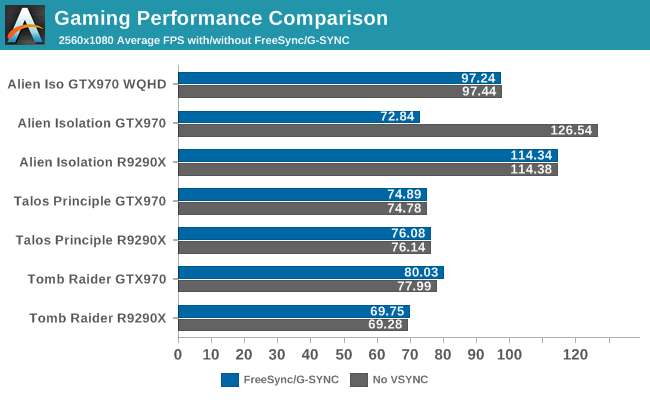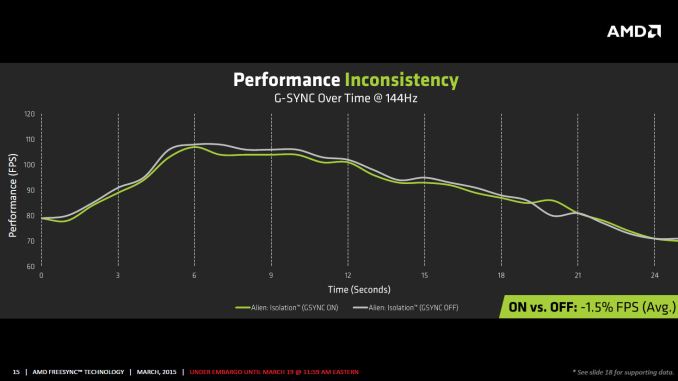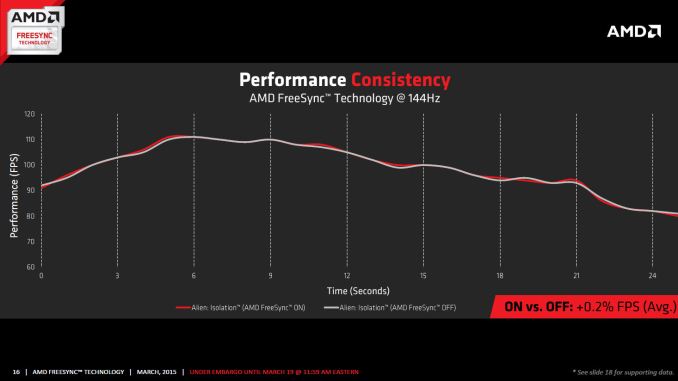The AMD FreeSync Review
by Jarred Walton on March 19, 2015 12:00 PM ESTFreeSync vs. G-SYNC Performance
One item that piqued our interest during AMD’s presentation was a claim that there’s a performance hit with G-SYNC but none with FreeSync. NVIDIA has said as much in the past, though they also noted at the time that they were "working on eliminating the polling entirely" so things may have changed, but even so the difference was generally quite small – less than 3%, or basically not something you would notice without capturing frame rates. AMD did some testing however and presented the following two slides:
It’s probably safe to say that AMD is splitting hairs when they show a 1.5% performance drop in one specific scenario compared to a 0.2% performance gain, but we wanted to see if we could corroborate their findings. Having tested plenty of games, we already know that most games – even those with built-in benchmarks that tend to be very consistent – will have minor differences between benchmark runs. So we picked three games with deterministic benchmarks and ran with and without G-SYNC/FreeSync three times. The games we selected are Alien Isolation, The Talos Principle, and Tomb Raider. Here are the average and minimum frame rates from three runs:


Except for a glitch with testing Alien Isolation using a custom resolution, our results basically don’t show much of a difference between enabling/disabling G-SYNC/FreeSync – and that’s what we want to see. While NVIDIA showed a performance drop with Alien Isolation using G-SYNC, we weren’t able to reproduce that in our testing; in fact, we even showed a measurable 2.5% performance increase with G-SYNC and Tomb Raider. But again let’s be clear: 2.5% is not something you’ll notice in practice. FreeSync meanwhile shows results that are well within the margin of error.
What about that custom resolution problem on G-SYNC? We used the ASUS ROG Swift with the GTX 970, and we thought it might be useful to run the same resolution as the LG 34UM67 (2560x1080). Unfortunately, that didn’t work so well with Alien Isolation – the frame rates plummeted with G-SYNC enabled for some reason. Tomb Raider had a similar issue at first, but when we created additional custom resolutions with multiple refresh rates (60/85/100/120/144 Hz) the problem went away; we couldn't ever get Alien Isolation to run well with G-SYNC using our custome resolution, however. We’ve notified NVIDIA of the glitch, but note that when we tested Alien Isolation at the native WQHD setting the performance was virtually identical so this only seems to affect performance with custom resolutions and it is also game specific.
For those interested in a more detailed graph of the frame rates of the three runs (six total per game and setting, three with and three without G-SYNC/FreeSync), we’ve created a gallery of the frame rates over time. There’s so much overlap that mostly the top line is visible, but that just proves the point: there’s little difference other than the usual minor variations between benchmark runs. And in one of the games, Tomb Raider, even using the same settings shows a fair amount of variation between runs, though the average FPS is pretty consistent.


















350 Comments
View All Comments
Refuge - Friday, March 20, 2015 - link
Thats the thing, this is clearly a tech that can help lower end GPU's provide a better gaming experience, and it is a patch away for nVidia.Them saying they won't or them just not doing it is honestly a slap in the face to every customer of theirs. Me included, I don't want my GPU to work better with one monitor than another because of a branding issue.
if nVidia doesn't support Freesync, I'll just never buy their products again. I honestly don't see why they wouldn't support it. Then their GPU's work with everything and AMD are still stuck to Freesync.
Not only is it insulting to me as a customer, it is also stupid from a business standpoint as well.
Creig - Friday, March 20, 2015 - link
AdaptiveSync - An open VESA industry standard available for free to any company that wishes to utilize it.G-sync - Nvidia's proprietary solution that they collect royalties on and refuse to allow any other company to use.
Big difference.
tobi1449 - Friday, March 20, 2015 - link
Plus I doubt the companies producing the scalers don't want their cut for additional features like this one.cbutters - Friday, March 20, 2015 - link
So you are arguing that the cost is that you have to stick with AMD hardware? For one, how is this a cost?? But my point is the only reason that you would have to stick with AMD hardware is because NVIDIA chooses not to support displayport 1.2a. So it is NVIDIA costing you.Secondly, You are not limited to AMD hardware, rather NVIDIA is excluding itself from your next purchase. Freesync is not closed tech... Intel graphics chips could adopt it tomorrow since it is an open standard. It is NVIDIA that is closing down options, not AMD.
JonnyDough - Monday, March 23, 2015 - link
Costs will trickle down somehow...yes with good PR. AMD spent a ton developing this only to give it away for free. It will pay because it makes NVidia look bad. I'm not a fanboy, I prefer NVidia's drivers usually. I just like AMD better because they compete on cost, not match it like an oligopoly.anubis44 - Tuesday, March 24, 2015 - link
"Costs still trickle down somehow..and that cost is you having to stick with AMD hardware when you buy a new monitor."That's not a cost AMD is imposing on us, it's a cost nVidia is imposing on us, by stubbornly refusing to give their customers Freesync compatible drivers. nVidia is simply trying to grab as much cash as possible, and people like you are helping them rip us all off.
chizow - Tuesday, March 24, 2015 - link
How is it not a cost AMD is imposing? LOL. FreeSync panels carry a premium over non-FreeSync panels, this is a fact. AMD has said it is the panel mfgs charging a premium for higher quality components, specifications, engineering/QA costs. No one has a problem with this, even AMD fanboys like you.Yet when Nvidia does the same, especially when their G-Sync module is clearly doing a better job at what it needs to do relative to the new FreeSync scalers, all while offering more features (3D and ULMB), suddenly there's a problem and Nvidia has no right?
LOL, idiots. Nvidia and their mfg partners are charging more because the market sees value in their superior products, simple as that. These are the same mfgs btw, if they thought they could charge more they would, but clearly, they also see the Nvidia solution commands the higher price tag.
medi03 - Wednesday, March 25, 2015 - link
BS.As mentioned in the article, FreeSync support is no big deal and is already supported by most upscaler chips out there. Had there been "hidden cost" they wouldn't do it.
FriendlyUser - Thursday, March 19, 2015 - link
How is it better because it works with Nvidia hardware? I mean, if you have a Nvidia card you don't have a choice. That doesn't make GSync better in any meaningful way.dragonsqrrl - Thursday, March 19, 2015 - link
... If you currently have an AMD card, you have much less of a choice. Actually given the restriction of GCN 1.1 or later, there's a decent possibility you have no choice.